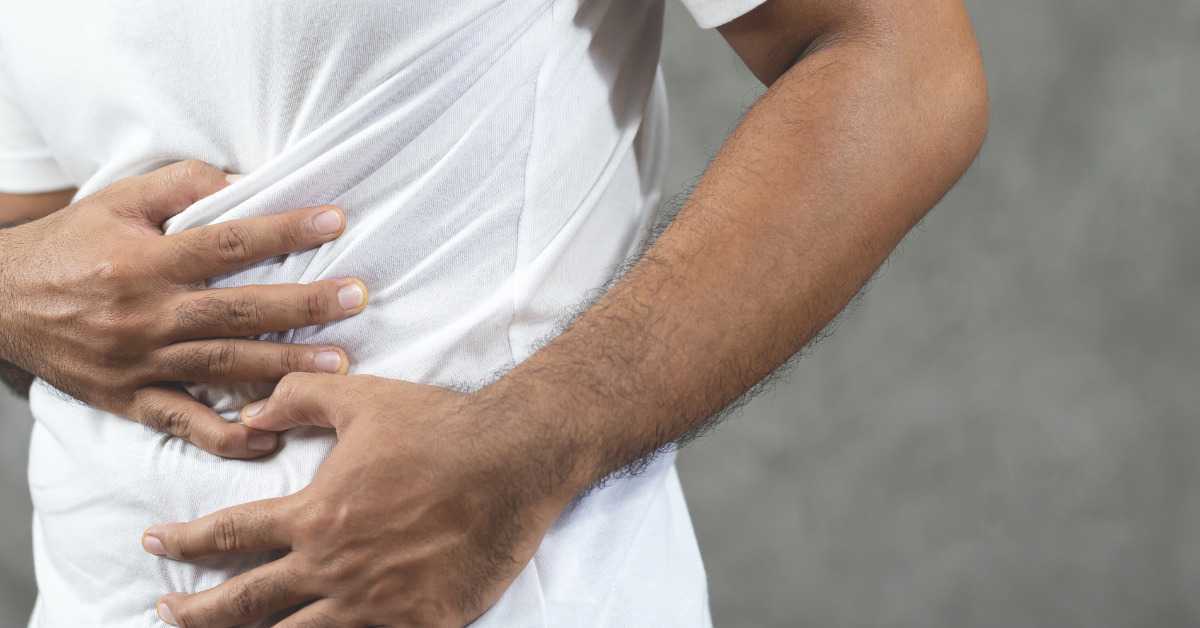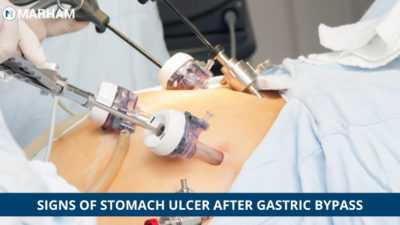One of the potential side effects from Roux-en-Y Gastric Bypass (RYGB) is ulcerations, which can hurt the patient and give the bariatric surgeon migraines. The gastrojejunal anastomosis’s marginal ulcer, or mucosal erosion, is the most common type of condition.
Medication can be used to treat this issue, but in more severe situations, surgery is required. A number of drugs, including NSAIDs, caffeinated beverages, alcohol, and smoking are significant risk factors for gastric bypass ulcers.
In-depth explanations of ulcer kinds, causes, Signs of Stomach Ulcer after Gastric Bypass and medical and surgical management are provided in this post.
What is an Ulcer?
The destruction of the mucosa, the lining of the digestive tract that serves as a barrier to protect gut hormones and digestive juices, causes ulcers. Erosions can develop in the duodenum, stomach, or esophagus. Although it normally is benign, stomach cancer can develop if it turns malignant.
You need an endoscopy to check the condition of your stomach coating and see if mucosal erosion is evident in order to identify whether or not you have an ulcer. Peptic ulcer disease is frequently brought on by drugs and excessive acid production. The most common symptom among ulcer patients is abdominal pain.
Other problems that subjects could have include bleeding, hematemesis, bloody faces, leaking, and in extreme circumstances perforation.
What Causes Ulcers After Bariatric Surgery?
After weight loss surgery, especially a gastric bypass, ulcers can develop at any time (early or late). Following RNY bypass, ulcers seldom (less than 16 percent of the time) form.
- Regular users of aspirin (ibuprofen) are not suitable candidates for gastric bypass surgery and should instead select gastric sleeve surgery.
- Acidic or spicy foods, drinking coffee, alcohol, steroids (Prednisone), tobacco use, NSAIDs (Ibuprofen, Motrin, Aleve, and Naproxen), Helicobacter Pylori (H. Pylori), stress, and non-absorbable sutures are the leading causes of gastric bypass ulcer.
- Smoking hinders scar healing by reducing the oxygen flow to the stomach lining tissues. Most bariatric programmes demand that you give up smoking before and after surgery.
- Non-Steroidal Anti-Inflammatory Drugs (NSAIDs) can cause stomach ulcers or inflammation (gastritis). The damages may start to appear as early as a few months or as late as several years.
Signs of Stomach Ulcer after Gastric Bypass
Following gastric bypass surgery, the following symptoms of stomach ulcers are most typical:
- Upper stomach pain (particularly right after eating), gas and bloating, nausea, vomiting, stoma obstruction, appetite loss, and bleeding (blood in the stool or vomit).
- Patients who have bleeding ulcers may develop anemia. You might also experience Gastrogastric Fistula, which causes extreme stomach pain, nausea, and vomiting when blood and acid seep from your pouch into your intestines.

- Asymptomatic Marginal Ulcer problems affect about 25% of patients. Do not disregard the signs.
- Ulcers can develop swiftly into a serious problem with life-threatening consequences.
- You run the risk of bleeding, stomach perforation, or even worse if you ignore these signs.
- Your doctor should be consulted to identify and treat any ulcers.
Types of Ulcers After Gastric Bypass
Due to intestinal rerouting, which joins the lower intestines to the stomach to skip digestion, marginal ulcers and stomal ulcers are more frequent. Marginal ulcers are frequently a side effect of smoking and using drugs like NSAIDs and steroids.
Patients with RNY are more prone to two main forms of ulcerations:
1. Duodenum Ulcer
Peptic ulcer refers to the eroded coating on the duodenal side of the remaining stomach or duodenum. Patients having any bypass are less likely to develop this kind of ulcer, which can be treated endoscopically.
2. Jejenum Ulcer
When the gastrointestinal anastomosis’ mucous membrane loses its structural integrity, a “marginal ulcer,” also known as a “anastomotic ulcer,” forms. The jejunal side of the gastrointestinal anastomosis is typically where the erosion occurs. Stomal ulcers, as they are known, are uncommonly encountered on the stomach pouch itself.
Anastomotic ulcer patients occasionally develop Gastro-Gastric Fistulae. Disruption of the staple line in the gastric remnant is the root cause of gastro-gastric fistula (GGF). Between the gastric pouch and the remaining stomach, there is anastomotic leakage. The lining of the small pouch might be harmed by the stomach’s acid production if it backs up into it.
Gastric Bypass Ulcer Treatment & Prevention
By doing an EsophagoGastroDuodenoscopy with a scope inserted through the mouth into the pouch, your doctor will check the ulcers (EGD). Usually, treating the ulcer with medicine will make it go. It is necessary to do surgery to address the issue in cases of bleeding and perforated ulcers.
Non-Surgical Treatment
Patients with RNY who have symptomatic stomach ulcers are typically treated with drugs like proton pump inhibitors (PPIs) and cytoprotectively medicines (sucralfate).
The PPI medical treatment prevents the stomach from producing acid, which treats the ulcer. Always seek advice from your primary care physician before taking PPIs or any specialized medication to treat nausea, vomiting, or stomach pain.
Surgical Treatment
Endoscopic therapy for bleeding ulcers has a reduced risk of complications than laparoscopic surgery. When lesions are present and stomach contents seep into the body due to a perforated ulcer, surgery is necessary to repair it. Chronic ulcers call for revisional surgery when they recover and never fully recover. Here are the best surgical fixes.
- Gastrojejunostomy (GJ) Revision – A fresh gastrojejunostomy is required for chronic and perforated anastomotic revision. Your bariatric surgeon must remove the ulcer and change how the pouch and small intestine are connected.
- Gastro-Gastric Fistula Revision – If there are difficulties with the fistula, a partial gastrectomy of the remaining stomach is also necessary as part of the treatment.
- Reversing the gastric bypass, either with or without a gastric sleeve, is another possibility.
Preventing Ulcers After Gastric Bypass Surgery
Post-bariatric surgery stomach ulcers are painful and depressing. Your chances of losing weight may be reduced by the discomfort and blood loss, which might lower energy levels.
The pouch might be reduced in size by the bariatric surgeon to help produce less acid. Additionally, absorbable sutures can be used to reduce the likelihood of ulceration. Fortunately, there are steps you may take to avoid developing stomach ulcers after surgery:
- Eat healthfully
- Steer clear of meals that make you feel sick.
- To stay hydrated, drink a lot of liquids, particularly water
- Avoid drinking alcohol after a gastric bypass
- Refrain from using tobacco and from smoking.
- Control your stress level.
- To assist in preserving the stomach lining, take the drugs that your surgeon has suggested.
Take Away
Patients who have bariatric surgery are free of both their underlying medical issues and their weight. After surgery, some patients may develop stomach ulcers.
Overall, properly following your surgeon’s instructions and regularly doing endoscopies are the best ways to avoid stomach ulcers following gastric bypass surgery.
Take charge of your health and monitor any changes in the signs and symptoms of a stomach ulcer. Contact your bariatric specialist straight away if you have any questions.
Book your appointment with the Best Gastroenterologists in Islamabad online via Marham today!
Can’t Find the App
| Android | IOS |
|---|---|
 |
 |
FAQ’S
Are stomach ulcers common after gastric bypass surgery?
The development of mucosal erosion at the gastrojejunal anastomosis, often on the jejunal side, is referred to as a marginal ulcer, or stomal ulceration. The majority of marginal ulcers appear during gastric bypass procedures*, where the distal stomach or gastric remnant is stapled but not split.
What causes stomach ulcers after gastric bypass?
Any time after a gastric bypass, ulcers might develop in the gastric pouch or at the gastrojejunal anastomosis. Excessive stress at the anastomotic site, the development of a gastrogastric fistula, and retained pouch parietal cells are all potential causes of these ulcers.
How long does it take for a marginal ulcer to heal?
Proton pump inhibitors (PPIs) were more effective at healing marginal ulcers in patients with Roux-en-Y gastric bypass just by opening the capsule, although it is still feasible to improve therapy. These ulcers took a median of 3 months to heal.

